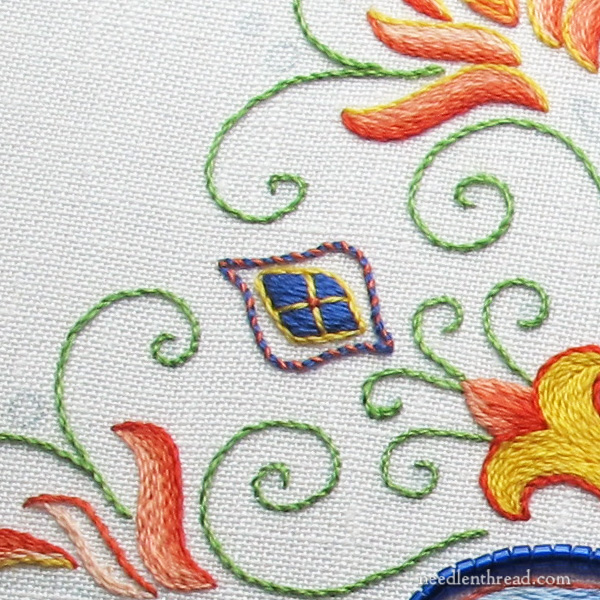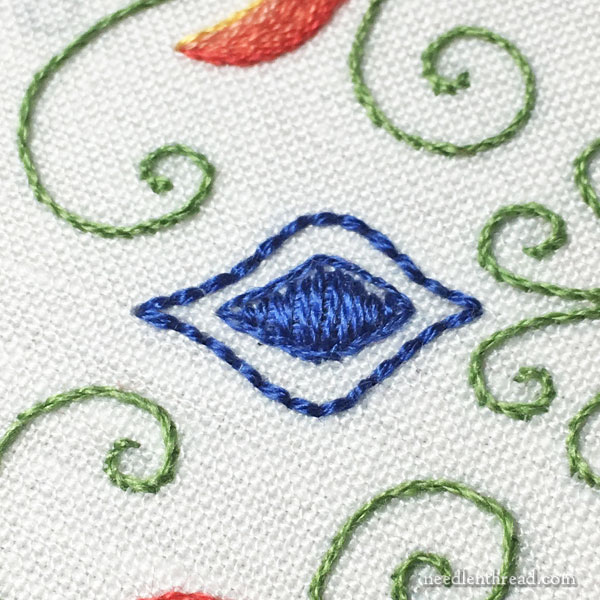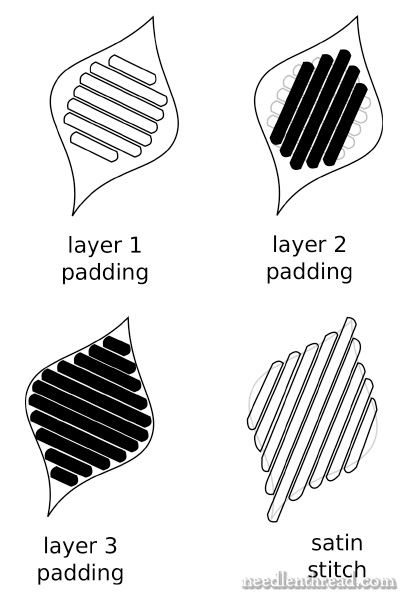Happy Friday, folks!
If you’ve been following along with Party in Provence, an embroidered kaleidoscope that we’ve been working through step-by-step here on Needle ‘n Thread, you might find it hard to believe that we’re Almost Finished!
Today, we’re going to add a very little touch to the kaleidoscope – it’s the tiny medallion between each arm of the design.
Even if you’re not actually stitching Party in Provence, the tips below for the techniques used on this element can be applied to your own embroidery projects.
So…here’s the little medallion for you.

This little element, which ties the large central flower in blues together with the outer layers of the design, is worked in padded satin stitch with a small lattice accent, stem stitch, and whipped backstitch.
When you look at the element, you might be tempted to work from inside out – the satin stitch center first, the lattice element on top of that, the stem stitch outline, and then the whipped backstitch outline beyond the center.
And if I hadn’t already stitched the thing, I’d probably approach it that way, too!
But since I’ve already stitched this little element a good eight times, I’ve learned a little tip.
Stitch the whipped backstitch outline first! Why? Because the satin stitch element gets in the way while you’re whipping the backstitch.
The outer line in whipped backstitch is worked with 2 strands of 797 (blue), whipped with one strand of 351 (coral).
You can find a video tutorial for whipped backstitch here.
Satin Stitch
The satin stitch element is padded, so let’s tackle the question of padding.

(You’ll notice above that I haven’t whipped the backstitch yet. I learned the hard way.)
Begin the satin stitched element by working a split stitch line using one strand of 797, covering the line. You can find a video tutorial for split stitch here.
Once you’ve split stitched that outline, it’s time to build up the padding layers inside.
You’ll keep using one strand of 797 for all of this, through the top layer of satin stitch.
To build up the padding and finish with the satin stitch, here’s a diagram of the steps and the stitch direction you’ll follow:

Each layer of padding is worked in straight stitches, filling the shape in progressive stages, until the third layer of padding sits perpendicular to the direction of the top layer of satin stitch.
New Floss and Satin Stitch Method
When you’ve finished the padding, switch to a brand new piece of floss, even if you have floss left over.
This is very important, because you want that final layer of satin stitch to look just perfect.
When you work the satin stitch, you’ll work it just over the split stitch outline. Start with the longest central satin stitch right down the middle of the element, and then work out to one side, go back to the middle, and work out to the other side.
End the satin stitch when it just barely starts to cover the side bulges. That side satin stitch will be a lot longer than you think it should be! The whole element can be covered in about 5 stitches altogether – maybe seven, if you work them very close, but try not to crowd them.
The Lattice & Outline
The lattice over the satin stitch is worked as one large X, so that the center of the X is approximately in the center of the element.
You’ll use one strand of yellow 725 for this.
Before ending the yellow, though, switch to one strand of 351 and work a tiny cross stitch over the intersection of the lattice.
Then, go back to the yellow and work a tiny stem stitch outline all around the center satin stitched element.

And this is where we are so far!
The next installment on this project will be the last! We’ll add the beads and then you can revel in your own beautiful finished kaleidoscope!
Looking for More?
If you want to follow this project from beginning to end – to stitch along, or just to pick up some stitching and technique tips – you can find the entire project in my Hand Embroidered Kaleidoscopes project index, along with several other step-by-step kaleidoscope projects.
If you’d like to stitch your own kaleidoscopes, interpreting them in any fun way you want, you might be interested in my pattern book for embroidered kaleidoscopes, Favorite Kaleidoscopes. It’s a lot of fun!
Let me know how you’re getting on with your Party in Provence! If you have any questions, don’t hesitate to leave a comment below.
And if you have photos you’d like to share, why not stop by the Needle ‘n Thread Community on Facebook and share them there? We’d love to see your progress!
Have a terrific weekend!